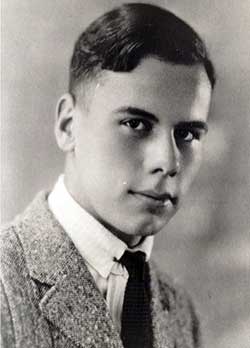
Biography of George Stibitz
George Robert Stibitz was born on 20 April, 1904, in York, Pennsylvania. His mother was the former Mildred Amelia Murphy, a math teacher before her marriage, and his father was George Stibitz, a professor of theology. George had a brother—Earle, and two sisters—Mildred and Eleanor.
George's childhood was spent in Dayton, Ohio, where his father taught at a local college. Stibitz, an experimenter at heart, had been intrigued by electrical gadgets since childhood, an interest that on occasion must have dismayed his parents. As a boy of eight in Dayton, Ohio, he nearly set the house on fire by overloading the circuits with an electric motor given him by his father.
Because of the interest in and aptitude for science and engineering that he had exhibited, George (see the lower photo) was enrolled at the experimental high school Moraine Park in Dayton, established by Charles Kettering, inventor of the first automobile ignition system.
 For his undergraduate studies, Stibitz enrolled at Denison University in Granville, Ohio. After earning his bachelor of philosophy degree there in 1926, he went on to Union College in Schenectady, New York, where he was awarded his M.S. degree in 1927. After graduating from Union College, he worked lonesome as a technician at General Electric research labs in Schenectady for one year, before returning to Cornell University to begin his doctoral program. Stibitz received his Ph.D. in mathematical physics from Cornell in 1930.
For his undergraduate studies, Stibitz enrolled at Denison University in Granville, Ohio. After earning his bachelor of philosophy degree there in 1926, he went on to Union College in Schenectady, New York, where he was awarded his M.S. degree in 1927. After graduating from Union College, he worked lonesome as a technician at General Electric research labs in Schenectady for one year, before returning to Cornell University to begin his doctoral program. Stibitz received his Ph.D. in mathematical physics from Cornell in 1930.
Stibitz's first job after graduation was as a research mathematician at the Bell Telephone Laboratories in New York City. His job there was to work on one of the fundamental problems with which modern telecommunication companies have to deal: How to carry out the endless number of mathematical calculations required to design and operate an increasingly complex system of telephones. At the time, virtually the only tool available to perform these calculations was the desktop mechanical calculator. It was obvious that this device would not long be adequate for the growing demands of the nation's expanding telephone network. His pioneering work in the field of digital computers is described in the article Relay computers of George Stibitz.
From 1941-1945 Stibitz served in the National Defense Committee, where he worked on important theoretical work dealing with computation. After the war he decided not to go back to Bell Labs, but to start a scientific and academic career. From 1945 to 1954, Stibitz worked as a private consultant in Burlington VT, developing a precursor to the electronic digital minicomputer. He joined the Dartmouth faculty and applied computer systems development to a variety of topics in biomedicine in 1964. In 1966 Stibitz became a Full Professor, and in 1970 he became a Professor Emeritus.
Stibitz married on September 1st, 1930, to Dorothea Lamson, with whom he had two daughters, Mary and Martha.
George Robert Stibitz held 38 patents, excluding those assigned to Bell labs. “Model K” a breadboard digital calculator could add two bits and display the results. Using only surplus relays, tin-cap strips, flash bulbs, and wire to make his “Model K”—a precursor to the Complex Number Calculator. His great contribution to Computer Science was his creation of the Complex Number Calculator, which first ran in January 8, 1940. This was the world’s first example of remote job entry, a technique that revolutionized dissemination of information through phones and computer networks. In 1965, he received the Harry Goode Award for lifetime achievement in engineering from AFIPS. Among the other awards he has received are the Harry Goode Award of the American Federation for Information Processing (1965), the Piore Award of the Institute of Electrical and Electronic Engineers (1977), and the Babbage Society Medal (1982). He was also the recipient of honorary degrees from Keene State College and Dartmouth College and was named to the Inventors Hall of Fame in 1983.
George Robert Stibitz died in his home in Hanover, New Hampshire, on January 31, 1995, at age of 90.